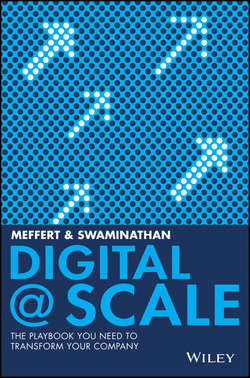Читать книгу Digital @ Scale - Swaminathan Anand - Страница 11
На сайте Литреса книга снята с продажи.
2
DIGITIZATION REQUIRES FUNDAMENTAL RENEWAL: DIGITAL@SCALE
2.2 WHAT? WHAT DOES DIGITIZATION MEAN FOR MY COMPANY, AND WHAT PRIORITIES ARE DERIVED?
ОглавлениеDigitization means different things to different people. We need a structure and a plan. To answer the “What?” question, it is helpful to build a three-stage structure that can be used to prioritize the strategic and operational tasks.
Building New Ecosystems
At the first level, New Ecosystems, strategic thinking is needed. Innovations arise at industry boundaries. This is all about the new markets that emerge as a result of the technological possibilities. In this book, we select nine of the most important new ecosystems. In Chapter 4, we discuss how digitization is changing mobility, how smart our homes will become, what will happen to commerce, what banks need to focus on, what will change in public administration, what digital health care will look like, the threats to telecommunications groups, how drastically logistics is changing, and how even old technologies like electricity grids are being revolutionized by digitization.
These are the strategic questions all managers need to ask themselves: are competitors attacking our business with new technologies? Are we grasping the opportunities of digitization and actively developing new value propositions? Are new profit pools emerging at the boundaries between traditional industries? The more unsettling the answers, the greater the willingness to revise the current business model and to accept cannibalization of revenues. A new vision for the company is needed with a convincing value proposition that takes into account the disruptive force of change.
Developing Business Architecture
The second level, Business Architecture, deals with operational questions: Are we using the opportunities of the digital world and reaching our customers at all contact points – both traditional and new? Are we leveraging all the advantages that digitization and new analysis methods offer? And how is digitization changing our management and administrative processes?
In Chapter 5, we describe how digitization is changing the business architecture, focusing on three areas: the customer experience, product innovation, and value added. The challenge is significant: digital attackers are strongest when it comes to the customer experience. With simple and reliable processes, they seamlessly shape the entire journey from first contact to completed order, often making traditional companies appear outdated. Many new players also benefit from open platforms for developments, thus increasing the innovation pace of their products. Billing, support, data analysis – the best attackers have digitized the entire value chain. However, digitization doesn’t just affect production areas; it also fundamentally changes management and administrative functions. These new players set the example for all companies that intend to take up the challenge.
Strengthening the Foundation
The third level, Foundation, deals with the technological and organizational frameworks. Typical questions include: are we employing state-of-the-art technology in our company? How can we make our company agile without taking on too many risks? How can we attract digital talent and build targeted partnerships?
In Chapter 6, we discuss the challenges for the foundation, and focus on two areas: technology as well as culture and organization. We start with a practical problem: an existing IT system cannot be replaced overnight if completely new skills are required for digital projects. Thus the company also needs a second pillar, an agile and fast separate IT system. To operate it, the best new digital talent may need to be hired – talent that expects flat hierarchies and cross-functional working. In short, both the culture and the organization need to be overhauled.
